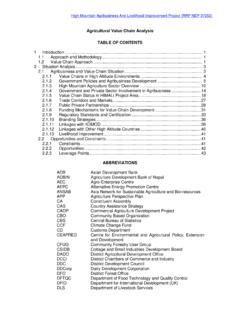Transcription of GUIDELINES FOR INTEGRATED MANAGEMENT OF ACUTE …
1 MINISTRY OF HEALTH. GUIDELINES FOR. INTEGRATED MANAGEMENT . OF ACUTE MALNUTRITION. IN UGANDA. January 2016. MINISTRY OF HEALTH. GUIDELINES FOR. INTEGRATED MANAGEMENT . OF ACUTE MALNUTRITION. IN UGANDA. January 2016. contents Foreword .. 11.. 12. Acronyms and Abbreviations .. 14. Glossary of Terms .. 16. CHAPTER ONE 19.. 19. Overview of Malnutrition in Uganda .. 19. ACUTE Malnutrition as a form of under-nutrition .. 19. Components of INTEGRATED MANAGEMENT of ACUTE Malnutrition (IMAM) .. 20. Principles of .. 21. Purpose of the IMAM GUIDELINES .
2 22. Integrating IMAM into the Existing Health Structure of Uganda .. 22. CHAPTER TWO 25. COMMUNITY INVOLVEMENT .. 25.. 25. Steps in community Mobilisation and Involvement .. 26. CHAPTER THREE 31. NUTRITION ASSESSMENT AND CLASSIFICATION OF ACUTE MALNUTRITION .. 31.. 31. Where the assessment/screening should be .. 31. Nutrition Assessment .. 33. Classification of ACUTE malnutrition .. 37. CHAPTER FOUR 43. SUPPLEMENTARY FEEDING PROGRAMME FOR MANAGEMENT OF MODERATE ACUTE . MALNUTRITION .. 43.. 43. Opening and Closing a Supplementary Feeding Programme.
3 53. Requirements and Process for Setting Up a Supplementary Feeding Site .. 54. 4 GUIDELINES FOR NTEGRATED MANAGEMENT OF ACUTE MALNUTRITION IN UGANDA JANUARY 2016. CHAPTER FIVE 59. Outpatient Therapeutic Care For The MANAGEMENT Of ACUTE Malnutrition With No Medical Complications .. 59.. 59. Admission Criteria for .. 60. Admission process and activities in OTC .. 61. Discharge Procedures .. 68. Process and Requirements for Setting-up an OTC .. 69. CHAPTER SIX 73. INPATIENT THERAPEUTIC CARE FOR MANAGEMENT OF ACUTE MALNUTRITION. WITH MEDICAL COMPLICATIONS.
4 73.. 73. Admission Criteria .. 73. Admission .. 74. Stabilisation Phase / Phase 1 .. 76. Rehabilitation Phase / Phase .. 92. Criteria to move from Phase II back to the Stabilisation Phase (Phase 1).. 94. CHAPTER SEVEN 97. INPATIENT MANAGEMENT OF INFANTS LESS THAN SIX MONTHS WITH .. 97.. 97. Admission Criteria .. 98. Stabilization .. 98. Monitoring infants with SAM .. 103. Infant feeding counselling and support .. 103. CHAPTER EIGHT 107. EMERGENCY NUTRITION RESPONSE ..107.. 107. Steps for Emergency Nutrition Response .. 108. General requirements for Emergency Nutrition Relief Programmes.
5 110. Exit Strategy for Emergency Nutrition Response (ENR).. 111. CHAPTER NINE 113. NUTRITION INFORMATION, EDUCATION AND COMMUNICATION ..113.. 113. Nutrition Education Programme .. 114. Communicating Nutrition Information .. 115. Procedures for planning and facilitating a nutrition education .. 115. Conducting a nutrition education .. 116. Key Nutrition Recommendations .. 117. JANUARY 2016 GUIDELINES FOR NTEGRATED MANAGEMENT OF ACUTE MALNUTRITION IN UGANDA 5. CHAPTER 10 121. MONITORING, SUPERVISION, REPORTING AND EVALUATION, QUALITY. IMPROVEMENT AND SUPPLY CHAIN MANAGEMENT FOR.
6 121.. 121. Key definitions .. 122. Monitoring of IMAM services .. 122. IMAM service .. 129. Reporting .. 129. Evaluation .. 130. Quality improvement in INTEGRATED MANAGEMENT of ACUTE .. 130. Supply chain MANAGEMENT for imam .. 136. REFERENCES ..138. ANNEXES 141. ANNEX .. 142. Equipment and supplies needed for a nutrition ward/unit .. 142. Ward .. 142. ANNEX .. 144. TRIAGE OF SICK .. 144. ANNEX 3 ..145. 3A: Weight-for-Length Reference .. 145. 3B: Weight-for- Height Reference .. 147. 3D: Body Mass Index reference .. 153. ANNEX .. 154. PROTOCOL FOR THE INPATIENT MANAGEMENT OF THE SEVERELY MALNOURISHED.
7 154. ANNEX .. 160. Target Weight for .. 160. ANNEX .. 162. Antibiotics Reference Card .. 162. ANNEX .. 164. Recipes for F-75 and F-100 .. 164. ANNEX 8 ..166. F-75, F100 and RUTF Reference .. 166. ANNEX 9: Therapeutic Milk Reference Cards for Infants Less than 6 Months with SAM ..171. 9A: Therapeutic milk reference cards for infants less than 6 months with SAM (stabilization phase). 171. 9B: Therapeutic milk reference Card for infants less than 6 months with SAM who are not breastfed (transition phase).. 172. 6 GUIDELINES FOR NTEGRATED MANAGEMENT OF ACUTE MALNUTRITION IN UGANDA JANUARY 2016.
8 ANNEX ..176. 24-HOUR FEED INTAKE CHART .. 176. ANNEX ..177. DAILY WARD FEED .. 177. ANNEX ..178. WEIGHT GAIN TALLY SHEET FOR WARD .. 178. ANNEX 13 ..179. MONITORING .. 179. ANNEX 14 ..182. Sample Discharge Card .. 182. ANNEX ..184. Specialized Nutritious Foods Sheet .. 184. ANNEX 16 ..186. CRITICAL CARE PATHWAY CHART (-5 pages).. 186. ANNEX 17: Referral Forms ..194. 17 A: Community Referral Form .. 194. 17 B: HMIS 032: Referral .. 195. ANNEX 18 ..196. INTEGRATED NUTRITION RATION .. 196. ANNEX 19 ..197. Health and Nutrition Education Record.
9 197. ANNEX 20 ..198. DOCUMENTATION JOURNAL FOR QI .. 198. JANUARY 2016 GUIDELINES FOR NTEGRATED MANAGEMENT OF ACUTE MALNUTRITION IN UGANDA 7. List of Tables*. Table 1: Grading of bilateral pitting oedema Table 2: Summary of Classification of ACUTE Malnutrition Table 3: Admission criteria to SFP. Table 4: SFP Rations and their Nutrition Value Table 5: Advantages and disadvantages of dry and wet ration Table 6: Routine Medications for Patients in SFP. Table 7: Types of Exits from SFP. Table 8: Discharge criteria from SFP. Table 9: Decision-making framework for opening a Supplementary Feeding Programme1.
10 Table 10: Guidance on criteria for closing SFPs Table 11: Routine Drugs and Supplements in OTC. Table 12: Appetite test for RUTF. Table 13: Energy and Nutrient Composition of RUTF (Plumpy' nut). Table 14: Types and Criteria for Exit from OTC. Table 15: Signs of dehydration Table 16: Summary of Antibiotics for Severely Malnourished Children Table 17: Routine Medicines and Supplements Table 18: Types of discharges, conditions and actions from ITC. Table 19: Key Nutrition Recommendations Table 20: Tools used in monitoring, supervision and reporting for IMAM program Table 21: Typical target levels for cure, mortality and defaulting rates Table 22: Coverage needed to effect a given reduction in GAM.



